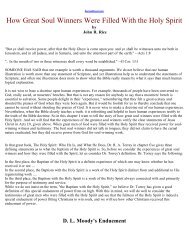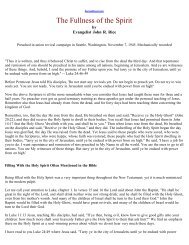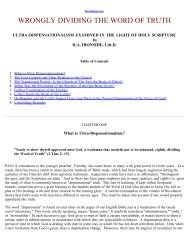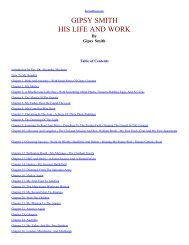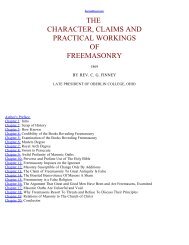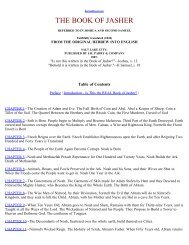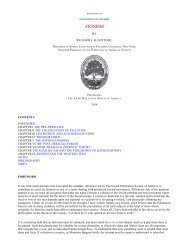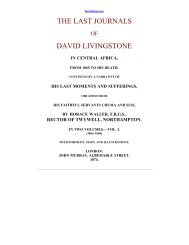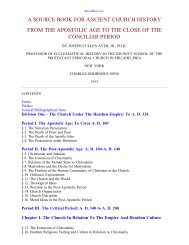Legends of Babylon and Egypt in Relation to Hebrew Tradition.pdf
Legends of Babylon and Egypt in Relation to Hebrew Tradition.pdf
Legends of Babylon and Egypt in Relation to Hebrew Tradition.pdf
You also want an ePaper? Increase the reach of your titles
YUMPU automatically turns print PDFs into web optimized ePapers that Google loves.
terrestrial experience. To-day we will exam<strong>in</strong>e the <strong>Egypt</strong>ian, Sumerian, <strong>and</strong> <strong>Babylon</strong>ian myths <strong>of</strong> Creation, <strong>and</strong>, after<br />
we have noted the more strik<strong>in</strong>g features <strong>of</strong> our new material, we will consider the problem <strong>of</strong> foreign <strong>in</strong>fluences upon<br />
<strong>Hebrew</strong> traditions concern<strong>in</strong>g the orig<strong>in</strong> <strong>and</strong> early his<strong>to</strong>ry <strong>of</strong> the world.<br />
In <strong>Egypt</strong>, as until recently <strong>in</strong> <strong>Babylon</strong>ia, we have <strong>to</strong> depend for our knowledge <strong>of</strong> Creation myths on documents <strong>of</strong> a<br />
comparatively late period. Moreover, <strong>Egypt</strong>ian religious literature as a whole is textually corrupt, <strong>and</strong> <strong>in</strong> consequence it<br />
is <strong>of</strong>ten difficult <strong>to</strong> determ<strong>in</strong>e the orig<strong>in</strong>al significance <strong>of</strong> its allusions. Thanks <strong>to</strong> the funerary <strong>in</strong>scriptions <strong>and</strong> that<br />
great body <strong>of</strong> magical formulae <strong>and</strong> ritual known as "The Chapters <strong>of</strong> Com<strong>in</strong>g forth by Day", we are very fully<br />
<strong>in</strong>formed on the <strong>Egypt</strong>ian doctr<strong>in</strong>es as <strong>to</strong> the future state <strong>of</strong> the dead. The <strong>Egypt</strong>ian's <strong>in</strong>tense <strong>in</strong>terest <strong>in</strong> his own remote<br />
future, amount<strong>in</strong>g almost <strong>to</strong> an obsession, may perhaps <strong>in</strong> part account for the comparatively meagre space <strong>in</strong> the<br />
extant literature which is occupied by myths relat<strong>in</strong>g solely <strong>to</strong> the past. And it is significant that the one cycle <strong>of</strong> myth,<br />
<strong>of</strong> which we are fully <strong>in</strong>formed <strong>in</strong> its latest stage <strong>of</strong> development, should be that which gave its sanction <strong>to</strong> the hope <strong>of</strong><br />
a future existence for man. The fact that Herodotus, though he claims a knowledge <strong>of</strong> the suffer<strong>in</strong>gs or "Mysteries" <strong>of</strong><br />
Osiris, should deliberately refra<strong>in</strong> from describ<strong>in</strong>g them or from even utter<strong>in</strong>g the name,[1] suggests that <strong>in</strong> his time at<br />
any rate some sections <strong>of</strong> the mythology had begun <strong>to</strong> acquire an esoteric character. There is no doubt that at all<br />
periods myth played an important part <strong>in</strong> the ritual <strong>of</strong> feast-days. But mythological references <strong>in</strong> the earlier texts are<br />
<strong>of</strong>ten obscure; <strong>and</strong> the late form <strong>in</strong> which a few <strong>of</strong> the s<strong>to</strong>ries have come <strong>to</strong> us is obviously artificial. The tradition, for<br />
example, which relates how mank<strong>in</strong>d came from the tears which issued from Ra's eye undoubtedly arose from a play<br />
upon words.<br />
[1] Herodotus, II, 171.<br />
On the other h<strong>and</strong>, traces <strong>of</strong> myth, scattered <strong>in</strong> the religious literature <strong>of</strong> <strong>Egypt</strong>, may perhaps <strong>in</strong> some measure betray<br />
their relative age by the conceptions <strong>of</strong> the universe which underlie them. The <strong>Egypt</strong>ian idea that the sky was a<br />
heavenly ocean, which is not unlike conceptions current among the Semitic <strong>Babylon</strong>ians <strong>and</strong> <strong>Hebrew</strong>s, presupposes<br />
some thought <strong>and</strong> reflection. In <strong>Egypt</strong> it may well have been evolved from the probably earlier but analogous idea <strong>of</strong><br />
the river <strong>in</strong> heaven, which the Sun traversed daily <strong>in</strong> his boats. Such a river was clearly suggested by the Nile; <strong>and</strong> its<br />
world-embrac<strong>in</strong>g character is rem<strong>in</strong>iscent <strong>of</strong> a time when through communication was regularly established, at least as<br />
far south as Elephant<strong>in</strong>e. Possibly <strong>in</strong> an earlier period the long narrow valley, or even a section <strong>of</strong> it, may have<br />
suggested the figure <strong>of</strong> a man ly<strong>in</strong>g prone upon his back. Such was Keb, the Earth-god, whose counterpart <strong>in</strong> the sky<br />
was the goddess Nut, her feet <strong>and</strong> h<strong>and</strong>s rest<strong>in</strong>g at the limits <strong>of</strong> the world <strong>and</strong> her curved body form<strong>in</strong>g the vault <strong>of</strong><br />
heaven. Perhaps still more primitive, <strong>and</strong> dat<strong>in</strong>g from a pas<strong>to</strong>ral age, may be the notion that the sky was a great cow,<br />
her body, speckled with stars, alone visible from the earth beneath. Reference has already been made <strong>to</strong> the dom<strong>in</strong>ant<br />
<strong>in</strong>fluence <strong>of</strong> the Sun <strong>in</strong> <strong>Egypt</strong>ian religion, <strong>and</strong> it is not surpris<strong>in</strong>g that he should so <strong>of</strong>ten appear as the first <strong>of</strong> created<br />
be<strong>in</strong>gs. His orb itself, or later the god <strong>in</strong> youthful human form, might be pictured as emerg<strong>in</strong>g from a lotus on the<br />
primaeval waters, or from a marsh-bird's egg, a conception which <strong>in</strong>fluenced the later Phoenician cosmogeny. The<br />
Scarabaeus, or great dung-feed<strong>in</strong>g beetle <strong>of</strong> <strong>Egypt</strong>, roll<strong>in</strong>g the ball before it <strong>in</strong> which it lays its eggs, is an obvious<br />
theme for the early myth-maker. And it was natural that the Beetle <strong>of</strong> Khepera should have been identified with the<br />
Sun at his ris<strong>in</strong>g, as the Hawk <strong>of</strong> Ra represented his noonday flight, <strong>and</strong> the aged form <strong>of</strong> Attun his sett<strong>in</strong>g <strong>in</strong> the west.<br />
But <strong>in</strong> all these varied conceptions <strong>and</strong> explanations <strong>of</strong> the universe it is difficult <strong>to</strong> determ<strong>in</strong>e how far the poetical<br />
imagery <strong>of</strong> later periods has transformed the orig<strong>in</strong>al myths which may lie beh<strong>in</strong>d them.<br />
As the <strong>Egypt</strong>ian Crea<strong>to</strong>r the claims <strong>of</strong> Ra, the Sun-god <strong>of</strong> Heliopolis, early superseded those <strong>of</strong> other deities. On the<br />
other h<strong>and</strong>, Ptah <strong>of</strong> Memphis, who for long ages had been merely the god <strong>of</strong> architects <strong>and</strong> craftsmen, became under<br />
the Empire the architect <strong>of</strong> the universe <strong>and</strong> is pictured as a potter mould<strong>in</strong>g the world-egg. A short poem by a priest<br />
<strong>of</strong> Ptah, which has come down <strong>to</strong> us from that period, exhibits an attempt <strong>to</strong> develop this idea on philosophical<br />
l<strong>in</strong>es.[1] Its author represents all gods <strong>and</strong> liv<strong>in</strong>g creatures as proceed<strong>in</strong>g directly from the m<strong>in</strong>d <strong>and</strong> thought <strong>of</strong> Ptah.<br />
But this movement, which was more notably reflected <strong>in</strong> Akhena<strong>to</strong>n's religious revolution, died out <strong>in</strong> political disaster,<br />
<strong>and</strong> the orig<strong>in</strong>al materialistic <strong>in</strong>terpretation <strong>of</strong> the myths was res<strong>to</strong>red with the cult <strong>of</strong> Amen. How materialistic this<br />
could be is well illustrated by two earlier members <strong>of</strong> the XVIIIth Dynasty, who have left us vivid representations <strong>of</strong><br />
the potter's wheel employed <strong>in</strong> the process <strong>of</strong> man's creation. When the famous Hatshepsut, after the return <strong>of</strong> her<br />
expedition <strong>to</strong> Punt <strong>in</strong> the n<strong>in</strong>th year <strong>of</strong> her young consort Thothmes III, decided <strong>to</strong> build her temple at Deir el-Bahari <strong>in</strong><br />
the necropolis <strong>of</strong> Western Thebes, she sought <strong>to</strong> emphasize her claim <strong>to</strong> the throne <strong>of</strong> <strong>Egypt</strong> by record<strong>in</strong>g her own<br />
div<strong>in</strong>e orig<strong>in</strong> upon its walls. We have already noted the <strong>Egypt</strong>ians' belief <strong>in</strong> the solar parentage <strong>of</strong> their legitimate



